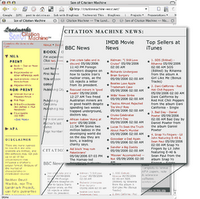 Conversations continue about schools that block access to the blogosphere. I ran across an interesting comment last night, in my end of the day aggregator scan. It was in a blog post by Wesley Fryer (Censored for Relevance – April 11, 2006), that he said, “Are we living in the United States here, or totalitarian China?”
Conversations continue about schools that block access to the blogosphere. I ran across an interesting comment last night, in my end of the day aggregator scan. It was in a blog post by Wesley Fryer (Censored for Relevance – April 11, 2006), that he said, “Are we living in the United States here, or totalitarian China?”
There are distinct differences between censorship in China and censorship in the U.S. In China, it is the government that is in a position of power, whereas, in the U.S. it is individuals and the mobs that they form that owns the power. But Fryer’s statement, I believe, is still a fair association. In both cases, censorship happens from the government’s fear of the people. China fears access to information that empowers people to challenge their authority. In the U.S. we fear challenge to the government’s ethicacy.
But the pivot point is not politics. It’s in the desperate belief that we can contain the information. It’s in our gatekeeper insistence that the information we do not want our children to have can be put on the highest shelves, hidden in the back of a closet, hidden within a brown paper wrapper, or rejected by editors and librarians,
The awful shame of it is that we have, as a result, convinced our children that their information is safe inside of their containers. Find your child’s MySpace writings and then question them. They will say, “That wasn’t for you.” “What are you doing in my space?” “How did you find that?” “How did you get there?” “I thought I was protected.” “I thought my information was containered for me and my friends.”
Because we still treat information as something that we can hide behind a wall, and we continue to teach that way to our children, they do not realize the dangers that their information represents to their personal safety and future well being.
Perhaps, we should stop thinking about the problem as something that we can cut off, like amputating a gangrenous arm. Instead, why not think of it as something that is integral to our culture — and treat it. What might we do to introduce a virus into MySpace.
“Ok students. This year, I’m going to be reading your MySpace writings and introducing topics that you write about in your space with our classroom discussions. We’ll use your information to learn.”
Posted later in the day
My final suggestion had an element of
tongue in cheek, because the students would certainly find a way to evade our interest. This fact was just brought to my attention in Andy Carvin’s blog,
Learning•Now, as he (
MySpace Is Just So Last Year) points us to a story in the Witchata Eagle, describing how students are finding alternative social spaces. Carvin also, in another post (
New Federal Legislation Would Ban Online Social Networks in Schools & Libraries), brings to our attention, a new bill being introduced in congress to force blocking of any social network web server for schools and libraries that are subsidized by federal dollars. GIVE ME A BREAK!
Photo Credits
Giuli@, “So Here We Are.” Giuli@’s Photostream. May 2, 2006. 11 May 2006 <http://flickr.com/photos/giulia_rossa/139146844/>.
Travelinlibrarian, “Leid Public Library.” Travelinlibrarian’s Photostream. May 10, 2006. 11 May 2006 <http://flickr.com/photos/travelinlibrarian/144280510/>.

 My friend, David Jakes, has posted a very useful list of factors that he believes, contribute to the sustainability of an innovation. I’m listing them here, but please head over the the
My friend, David Jakes, has posted a very useful list of factors that he believes, contribute to the sustainability of an innovation. I’m listing them here, but please head over the the  I heard some buzz about a movement toward customer created ads. It started with MoveOn’s Defeat Bush Ad contest, back in 2003. This one comes from
I heard some buzz about a movement toward customer created ads. It started with MoveOn’s Defeat Bush Ad contest, back in 2003. This one comes from  Conversations continue about schools that block access to the blogosphere. I ran across an interesting comment last night, in my end of the day aggregator scan. It was in a blog post by Wesley Fryer (
Conversations continue about schools that block access to the blogosphere. I ran across an interesting comment last night, in my end of the day aggregator scan. It was in a blog post by Wesley Fryer ( I’ve been trying to reconcile some of the problems that I see in the way that we inflict education on children today. For instance, think about this. There are a large number of teachers in our (U.S.) classrooms today who are around my age, fifty something. In the last half of our careers we have witnessed astounding changes in the very nature of information, and these changes are only accelerating. So here’s the math.
I’ve been trying to reconcile some of the problems that I see in the way that we inflict education on children today. For instance, think about this. There are a large number of teachers in our (U.S.) classrooms today who are around my age, fifty something. In the last half of our careers we have witnessed astounding changes in the very nature of information, and these changes are only accelerating. So here’s the math.
 Each year, about this time, the eclipse begins, as the shadow cast upon education discourse begins its irresistible march toward the end of the school year. Discussion boards and mailing lists slow to a crawl. E-mail all but disappears and blogging? Well we’ve only seen one summer of education blogging, so no trend has made itself apparent. We have seen some bloggers, during the summer months of 2005, disappeared completely into the darkness, never to be heard from again. Others, however, found their traction during the months of sunshine and frolic. ..And certainly, the summer conferences will spark much blogging and podcasting.
Each year, about this time, the eclipse begins, as the shadow cast upon education discourse begins its irresistible march toward the end of the school year. Discussion boards and mailing lists slow to a crawl. E-mail all but disappears and blogging? Well we’ve only seen one summer of education blogging, so no trend has made itself apparent. We have seen some bloggers, during the summer months of 2005, disappeared completely into the darkness, never to be heard from again. Others, however, found their traction during the months of sunshine and frolic. ..And certainly, the summer conferences will spark much blogging and podcasting. I’ve also run across a couple of blogs, people talking about Citation Machine, ..and apparently, some folks on a listserv are grumbling about my putting Google Ads on the tool. By the way, Google Ads work. I’ve calculated that if the the load on SOCM were to continue through the year, I could make just about as much money as I did my first year teaching. Of course, my first year teaching earned me less than $7000. The problem is that upgrading to a dedicated server is going to cost a lot of money, like a car payment — a really nice car, car payment. So Google Ads, stay 😉
I’ve also run across a couple of blogs, people talking about Citation Machine, ..and apparently, some folks on a listserv are grumbling about my putting Google Ads on the tool. By the way, Google Ads work. I’ve calculated that if the the load on SOCM were to continue through the year, I could make just about as much money as I did my first year teaching. Of course, my first year teaching earned me less than $7000. The problem is that upgrading to a dedicated server is going to cost a lot of money, like a car payment — a really nice car, car payment. So Google Ads, stay 😉 But hey! I’m really beginning to second think this. The problem isn’t that the kids don’t know about paper mills, and hiding them doesn’t solve the problem. The problem is with students who think they might just get away with turning in a purchased paper. They should know, be told, that we know about the paper mills too, and that we know how to detect them, that we have ways of telling when a student wrote it and when someone else got payed to write it. Students don’t plagiarize because they’re smart. They plagiarize because they’re lazy. We’re not lazy. We’ll catch them. They need to hear that in their schools from their increasingly tech-savvy teachers.
But hey! I’m really beginning to second think this. The problem isn’t that the kids don’t know about paper mills, and hiding them doesn’t solve the problem. The problem is with students who think they might just get away with turning in a purchased paper. They should know, be told, that we know about the paper mills too, and that we know how to detect them, that we have ways of telling when a student wrote it and when someone else got payed to write it. Students don’t plagiarize because they’re smart. They plagiarize because they’re lazy. We’re not lazy. We’ll catch them. They need to hear that in their schools from their increasingly tech-savvy teachers.